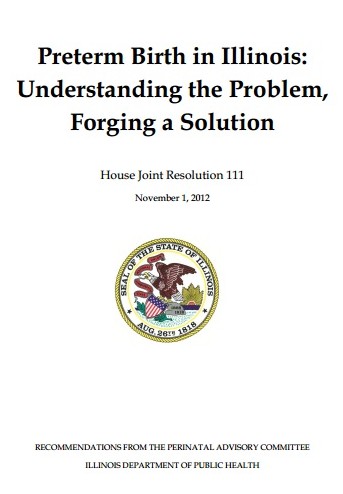This report from the Perinatal Advisory Committee of the Illinois Department of Public Health provides findings and recommendations concerning reducing preterm births in Illinois. SUMMARY OF FINDINGS The Problem: Preterm Birth and its Consequences
Preterm birth affects one in eight babies in the  United States, and 21,168 infants per year in Illinois (National Center for Health Statistics, 2009). Forging solutions to reduce preterm birth rates and improve pregnancy outcomes is one of the most urgent problems in maternal child health today. Infants born prematurely, or before 37 weeks completed gestation, suffer from increased risk of lifelong disabilities, including cognitive and learning problems, cerebral palsy, neurological problems, respiratory problems, and vision and hearing loss. These infants also are at an increased risk for Sudden Unexpected Infant Death (SUID), conditions such as Attention Deficit-Hyperactivity Disorder (ADHD), and recurrent hospitalizations. Preterm birth is the leading cause of infant mortality and newborn death. The significant and persistent racial, ethnic, and socioeconomic disparities in the rate of babies born too soon are deeply concerning. The consequences of an infant born prematurely have considerable emotional and financial impact on families, communities, and public-sector services. According to the Institute of Medicine, the annual societal economic burden associated with preterm birth in the United States was at least $26.2 billion in 2005, or $51,600 per infant born preterm.
United States, and 21,168 infants per year in Illinois (National Center for Health Statistics, 2009). Forging solutions to reduce preterm birth rates and improve pregnancy outcomes is one of the most urgent problems in maternal child health today. Infants born prematurely, or before 37 weeks completed gestation, suffer from increased risk of lifelong disabilities, including cognitive and learning problems, cerebral palsy, neurological problems, respiratory problems, and vision and hearing loss. These infants also are at an increased risk for Sudden Unexpected Infant Death (SUID), conditions such as Attention Deficit-Hyperactivity Disorder (ADHD), and recurrent hospitalizations. Preterm birth is the leading cause of infant mortality and newborn death. The significant and persistent racial, ethnic, and socioeconomic disparities in the rate of babies born too soon are deeply concerning. The consequences of an infant born prematurely have considerable emotional and financial impact on families, communities, and public-sector services. According to the Institute of Medicine, the annual societal economic burden associated with preterm birth in the United States was at least $26.2 billion in 2005, or $51,600 per infant born preterm.
